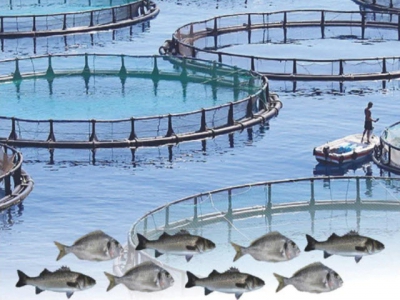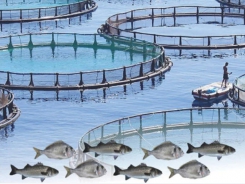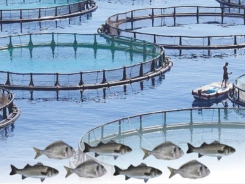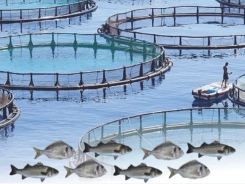A Guide to Acceptable Procedures Practices for Aquaculture Fisheries Research - Part 4

1. Animal husbandry (next)
1.2. Diseases and health management
1.2.5. Treatment of bacterial infections
Broad-spectrum antibiotics such as oxytetracycline (OTC) are utilized in the treatment of some bacterial infections in fish. OTC is an artificially engineered antibiotic used sparingly to combat bacterial infection, but it can also be used as a biological tagging agent in age/growth experiments (skeletal chronology). OTC is available in powder and liquid forms and may be applied to fish externally (by bathing or immersion), orally (by ingestion) or by intraperitoneal injection. Because there are registered or permitted products available OTC may be used in accordance with those permits even for food fish. For research use (not involving human consumption—see above) no withholding period is required and off-label use is allowed.
Other antibiotics, such as florfenicol, have also been permitted for food fish under certain conditions.
Bathing / Immersion
During bathing or immersion the OTC acts at the site of infection, and is absorbed through the gill filaments into the blood stream. This method has generally been more effective than all other methods of antibiotic treatment. OTC solution is added directly to tanks at rates of 20 mg/L active ingredient for 7 days at 20°-30°C and 10 days at < 20°C. During treatment water should be well aerated and fish should not be fed.
Medicated feed
For details of antibiotic treatment using pelleted, medicated feed see Read et al. (2007). For marine fish, a soft pellet can be prepared by combining 2 kg of minced pilchard and 3 kg of pellet crumble with OTC powder. The recommended pellet concentration of OTC is 50-100mg of OTC/kg of pelleted feed. Pellets can also be directly coated with OTC. Vitamin C (ascorbic acid) is often added at a concentration of 0.5 - 1.0 g/5 kg to pelleted feed to assist in the healing process and to reduce associated stress. Oxolinic acid too can be used as a treatment itself and is also a good agent for prophylactic purposes.
Intraperitoneal injection
Treatment with OTC by injection into the intraperitoneal cavity is used for skeletal chronology (to mark the bones of fishes for aging or tagging purposes), but it may also be used therapeutically, especially for larger fish or when it isn’t possible to feed or immerse the animal requiring treatment. There are several liquid forms of OTC available for injection. Recommended OTC injection rates are 50 - 100 mg/kg body weight.
1.2.6. Treatment of Ectoparasitic and Fungal infections – Formalin
Formalin is used in ponds or tanks for marine and freshwater fish both as an antifungal agent and for the control of ectoparasitic diseases of fish, and fish eggs (GESAMP, see reference list).
Baths may be short-term and high concentrations or long-term, low concentrations (see Table below). Formalin removes oxygen from water, and therefore ponds and tanks must be aerated during treatment (Rowland & Ingram, 1991; Rowland et al. 2007). Formalin is rapidly depleted to below therapeutic levels within 48 h in ponds, and so control of some diseases such as ichthyophthiriosis which has a complex life cycle depends on applications every second day until the disease is controlled. Some gill flukes lay eggs and control of these parasites is dependent on at least three consecutive applications, 1-3 weeks apart.
Formalin concentrations and application to control some fish diseases.

Because there are registered or permitted products available formalin may be used in accordance with those permits even for food fish. For research use (not involving human consumption—see above) no withholding period is required and off-label use is allowed.
WARNING: Formalin is a potential carcinogen and should be handled carefully as to avoid skin contact, eye irritation and inhalation (Katz, 1989).
1.2.7. Treatment of Ectoparasitic infections – Trichlorfon
Trichlorfon (Neguvon®) is an organophosphate that controls infestations of ectoparasites such as gill flukes and anchor worm (Lernaea sp.). Treatment with a Neguvon (anthelmintic powder) bath over a twelve to fourteen day period is often a successful treatment for dactylogyrid gill flukes. If fish show signs of stress due to ectoparasites or if a treatment appears unsuccessful (ie. the fish continue to display symptoms of stress, such as continuous flashing) further diagnosis is necessary. Fish should be examined after all treatments to evaluate effectiveness. For use on freshwater finfish refer to APVMA permit PER9750 before use.
Recommended Neguvon bath treatment.

NB: There is no treatment required on days 2, 4 and 6, etc.
Neguvon breaks down quickly. During treatment it is also advised to maintain the 10-20 % exchange water rate. It is possible for the treatment concentration to be doubled to 2.0 mg/L if required, however 1.0 mg/L is the preferred concentration. As the required concentration of Neguvon is quite low, preparing a larger volume of treatment solution will ensure greater accuracy of treatment concentration.
Fish should be closely monitored for signs of distress during treatments. Neguvon can become toxic to fish if stored incorrectly or if used past its expiry date.
NB. Read the label safety directions and refer to APVMA permit PER9750 before use.
Because there are registered or permitted products available Neguvon may be used in accordance with those permits, or under written veterinary direction, even for food fish. For research use (not involving human consumption—see above) no withholding period is required and off-label use is allowed.
1.3. Signs and management of stress
Stress is a general physiological reaction to trauma, or to a physical or psychological threat to the body that impairs normal functioning, and reduces performance and chances of survival. Stress may be acute (eg. netting, rough handling, low dissolved oxygen) or chronic (eg. very high stocking densities, aggression, poor nutrition). Stress can lead to reduced feed intake, slower growth, and lower resistance to infectious diseases. Signs of stress include: changes in feeding behaviour, including loss of appetite; abnormal or unusual colour (pale, dark, blotchy); abnormal behaviour (flighty, erratic swimming, swimming slowly, gasping at surface); lack of response to stimuli; congregation near surface or edges. Stress is minimised by: good water quality; appropriate stocking densities; adequate quantities of a nutritionally-complete diet for fish receiving artificial feed; a stable environment; limited physical disturbance; careful handling (facilitated by knotless nets, anaesthetics); and protection from bird predation in ponds.
1.4. Hatchery requirements
Marine and freshwater hatcheries are facilities that generally house and maintain a variety of animals including algae, invertebrates (as live feeds), larvae, fry, fingerlings and broodstock. It is important that hatchery procedures and protocols are developed, recorded and made readily available to all staff working within the unit. Design and operation of freshwater fish hatcheries are described in detail in Rowland and Bryant (1995) and Rowland and Tully (2004).
The following are key areas that should be addressed by hatchery managers.
Culture tanks
Tanks should be appropriate size and design, details of ACEC requirements are listed in 3.1.
Management of tanks
Water supply and drainage, aeration, screens, general management, standard hygiene and sterilization procedures.
Stocking of larvae
Quarantine and acclimation procedures.
Record keeping
Records of individual ponds, tanks and other facilities; date, daily events, feeding, treatments, water quality, mortalities, animal numbers, carer in charge.
Feeding
Live feeds, (rotifers and brine shrimp), weaning, artificial diets, nutrition, food storage and preparation.
Harvesting / Size grading
Procedures associated with harvesting/grading regarding methods, handling, destination of animals harvested etc.
Related news
Tools

Phối trộn thức ăn chăn nuôi

Pha dung dịch thủy canh

Định mức cho tôm ăn

Phối trộn phân bón NPK

Xác định tỷ lệ tôm sống

Chuyển đổi đơn vị phân bón

Xác định công suất sục khí

Chuyển đổi đơn vị tôm

Tính diện tích nhà kính

Tính thể tích ao




 Seafood exports recover to pre-pandemic levels
Seafood exports recover to pre-pandemic levels  A Guide to Acceptable Procedures Practices for Aquaculture…
A Guide to Acceptable Procedures Practices for Aquaculture…